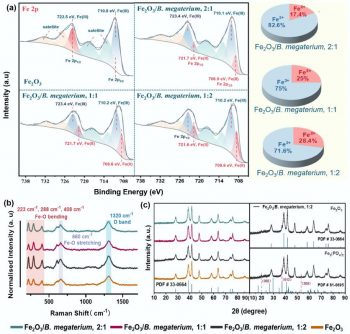Science
Innovative Biofilms Use Solar Energy to Clean Polluted Soils

Recent research has unveiled a groundbreaking approach to environmental cleanup, leveraging the interaction between solar energy, iron minerals, and bacteria to degrade pollutants in soil and groundwater. A study published on September 15, 2025, in the journal Environmental and Biogeochemical Processes by researchers from Kunming University of Science and Technology and the University of Massachusetts, explores how these mineral-bacterial biofilms can significantly enhance the degradation of common antibiotics such as tetracycline hydrochloride (TCH) and chloramphenicol (CPL).
The research highlights an innovative method that taps into the natural ability of non-phototrophic microorganisms to harvest solar energy. Traditionally, sunlight is understood primarily as a driver of photosynthesis in plants. However, recent findings indicate that microorganisms present in soils and sediments can also utilize solar radiation through interactions with minerals. This discovery opens up new avenues in bioremediation techniques, suggesting that solar energy can play a crucial role even in dark environments, such as saturated soils.
In this study, the team investigated the interactions between iron minerals, specifically Fe2O3 and FeOOH, and the bacterium Bacillus megaterium. They focused on how these interactions facilitate the accumulation and release of electrons during light-dark cycles. The co-culturing system demonstrated a continuous charge-discharge function, showcasing what the researchers describe as a “photovoltaic memory” effect.
The results revealed that the electron storage capacity, measured as the total accumulated charge (∑σ), increased with higher densities of bacterial biofilms. This indicates that denser biofilms are more efficient in capturing and storing energy. Notably, the research showed that charge accumulation was significantly higher during light exposure, with accumulated charges rising from 2.87 μC·cm−2 to 4.08 μC·cm−2 after several cycles.
One of the most compelling findings from the study is the enhanced degradation efficiency of pollutants following exposure to light. After just 60 minutes of light exposure, the degradation efficiency for TCH improved by 66.7%, while CPL saw a 46.7% improvement. This enhanced degradation is attributed to the synergistic interaction between the iron minerals and bacteria, which enables efficient electron transfer and storage, effectively allowing the system to act as a “biological capacitor.”
The structural and electrochemical analyses conducted as part of the study support the conclusion that these bacteria-mineral biofilms can significantly improve pollutant degradation. The research team suggests that this Fe2O3/B. megaterium biofilm system presents a sustainable and scalable solution for addressing environmental pollution, particularly in soil and groundwater.
This innovative approach does not require constant illumination, making it a practical solution for bioremediation in various ecosystems. The capacity of these biofilms to store and release energy in dark environments could transform current bioremediation practices, offering a cost-effective and energy-efficient option for cleaning up antibiotic-contaminated sites.
The study was supported by several funding sources, including the National Natural Science Foundation of China and the National Key Research and Development Program of China, among others.
As researchers continue to explore the potential of solar-powered biofilms, this work stands out as a significant advancement in the field of environmental science, paving the way for new strategies to combat soil and water pollution.
For more details, the complete study can be accessed at DOI 10.48130/ebp-0025-0006.
-

 Politics1 week ago
Politics1 week agoDallin H. Oaks Assumes Leadership of Latter-day Saints Church
-

 Sports1 week ago
Sports1 week agoSteve Kerr Supports Jonathan Kuminga After Ejection in Preseason Game
-

 Business1 week ago
Business1 week agoTyler Technologies Set to Reveal Q3 2025 Earnings on October 22
-

 Lifestyle1 week ago
Lifestyle1 week agoDua Lipa Celebrates Passing GCSE Spanish During World Tour
-

 Entertainment1 week ago
Entertainment1 week agoZoe Saldana Advocates for James Cameron’s Avatar Documentary
-

 World1 week ago
World1 week agoD’Angelo, Iconic R&B Singer, Dies at 51 After Cancer Battle
-

 Health1 week ago
Health1 week agoRichard Feldman Urges Ban on Menthol in Cigarettes and Vapes
-

 Health1 week ago
Health1 week agoCommunity Unites for Seventh Annual Mental Health Awareness Walk
-

 Science1 week ago
Science1 week agoChicago’s Viral ‘Rat Hole’ Likely Created by Squirrel, Study Reveals
-

 Lifestyle1 week ago
Lifestyle1 week agoKelsea Ballerini Launches ‘Burn the Baggage’ Candle with Ranger Station
-

 Business1 week ago
Business1 week agoMega Millions Jackpot Reaches $600 Million Ahead of Drawings
-

 Business1 week ago
Business1 week agoMLB Qualifying Offer Jumps to $22.02 Million for 2024







